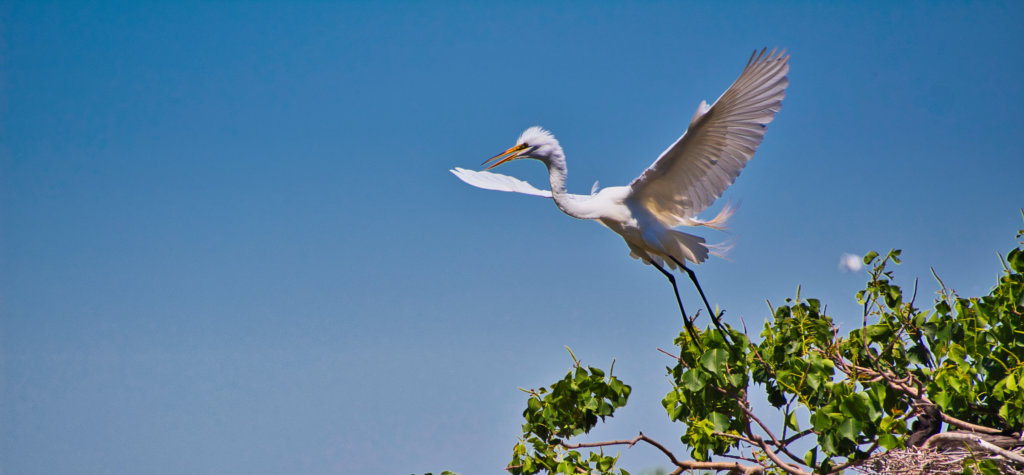Birdwatchers and Photographers flock to Galveston as it is one of the top locations in the country for birding. It hosts a wide variety of habitats in a small geographical area where some 300 species make their permanent or temporary home throughout the year. Here are 10 fantastic locations for birdwatching and catching a photo of your favorite rare birds.
1. East End Lagoon, Big Reef Nature Park.
A 684-acre tract of natural coastal prairie is east of Seawall Boulevard along Boddeker near Apffel Park in Galveston.
What you might see: Shorebirds, birds of prey and migrating birds. Black skimmers, terns and piping plovers nest along the beach front, while red-winged blackbirds rest in the tall grasses. Egrets and herons fish in the lagoon.
2. Corp Woods Nature Sanctuary:
This heavily wooded area is near Ferry Road by the U.S. Coast Guard headquarters in Galveston. Take a right onto Texas 168 to the parking area.
What you might see: During spring migration, abundant tanagers, orioles and buntings.
3. Offatts Bayou:
Best viewing is from parking areas on the west side of 61st Street in Galveston.
What you might see: Loons, grebes and diving ducks in winter, and eared grebes and red-breasted mergansers from late winter to spring.
4. 8 Mile Road, Sportsman Road and Lafitte’s Cove Nature Preserve:
Travel west on Seawall Boulevard and turn right onto 8 Mile Road for superb water birding. You can look for birds all the way to the bay or turn left on Sportsman Road. Lafitte’s Cove is off Stewart Road on Eckert Drive between 11 Mile and 12 Mile roads. Parking area is next to a boardwalk.
What you might see:Â Waders, shorebirds, oystercatchers. At Lafitte’s Cove: warblers, vireos, thrushes, ducks, shorebirds, snipe.
5. Galveston Island State Park:
14901 FM 3005. West of Galveston on Seawall Boulevard, which becomes FM 3005, the state park provides a sample of all the habitats found on the island. It includes 2,000 acres reaching from the Gulf of Mexico to West Bay.
What you might see: All-year-round wading birds, and for summer or winter, birds that prefer open prairie and wetlands. Ted Eubanks has compiled a checklist of birds seen at the park. Ask for a copy at the parks Nature Center.

6. West End: Dos Vacas, San Luis Pass Flats:
Dos Vacas Muertas is a small preserve with salt cedar trees and a fresh water pond. Take FM 3005 west. The entry for Dos Vacas is just before Sea Isle. San Luis Pass is about 2 miles west in Galveston.
What you might see: Pelicans, sandpipers, gulls, avocets, herons, egrets, raptors, sparrows, grebes, loons. Colonies of terns nest at San Luis Pass.
7. Bolivar Flats Shorebird Sanctuary:
Bolivar Flats on Bolivar Peninsula combines salt marsh, mud flats and beach habitats. So rich is the bird life, that it has been designated a Globally Important Bird Area. From Galveston, take Broadway to Seawall Boulevard. Turn left on Seawall. Turn left on Ferry Road to the Galveston-Bolivar Ferry terminal. You’ll exit the ferry on state Highway 87. Follow this for 3.7 miles to Rettilon Road. Turn right and drive to the beach.
What you might see: A huge variety of species, including: gulls, terns, pelicans, herons, egrets and spoonbills.
8. High Island: Boy Scouts Woods, Smith Woods and the Rookery:
Houston Audubon Society has four nature sanctuaries at High Island, including Boy Scout Woods, and Smith Oaks, which is home to the Rookery. There is a minimal fee to visit, which helps with the cost of maintenance. Take the Galveston-Bolivar Ferry (be sure to pack some bread for the gulls and feed off the back of the boat) and continue on state Highway 87 through Crystal Beach to High Island.
What you might see: The U-shaped island in the middle of Claybottom Pond at Smith Oaks has become a favored roosting and nesting place for thousands of water birds. In the spring and summer, herons, egrets, cormorants and spoonbills build their nests and raise their chicks.
9. Anahuac National Wildlife Refuge:
4318 FM 1985. This 34,000-acre coastal marsh and prairie borders Galveston Bay.
What you might see: Egrets, bitterns, hawks, kites and eagles. Storks, pheasants, turkeys, falcons, ibises and spoonbills, cranes, plovers, stilts and avocets, ducks, geese, swans, sandpipers, rails, gallinules and coots.
10. Texas City Dike and Levee Loop:
The Texas City Dike is a great birding experience about 20 miles from Galveston. Take the Texas City exit on Interstate 45 and continue on state Highway 146. Turn right on Texas Avenue, left on Bay Street Road, and then right on Texas City Dike Road.
What you might see: Brown pelicans, willets, laughing gulls, forsters terns, waders and black skimmers. In winter, you can also see loons, grebes, and bay ducks.
Be Sure to check out the annual FeatherFest:

